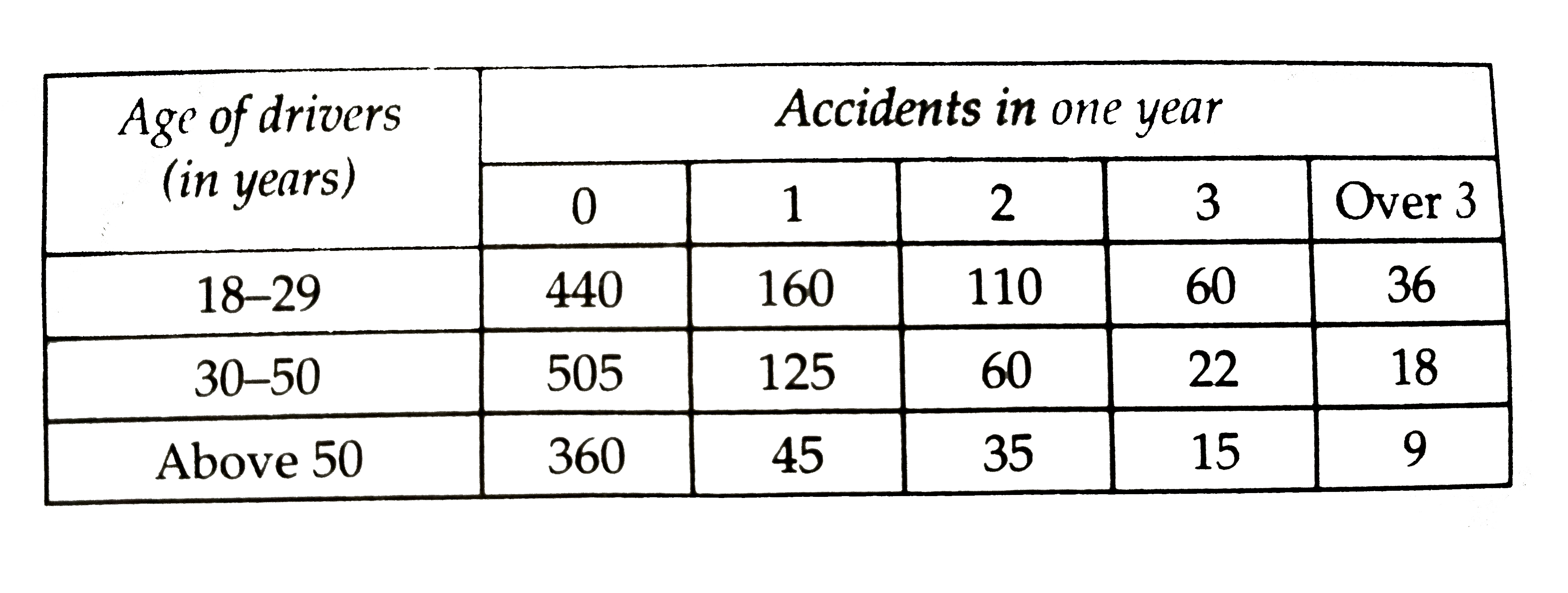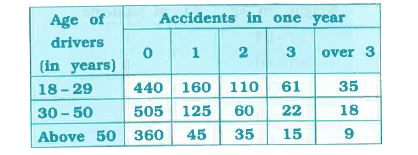An insurance company selected 2000 drivers at random (i.e., without any preference of one driver over another) in a particular city to find a relationship between age and accidents. The data obtained is given in the following table:

Find the probabilities of the following events for a driver chosen at random from the city:
(i) The driver being in the age group 18-29 years and having exactly 3 accidents in one year.
(ii) The driver being in the age group of 30-50 years and having one or more accidents in a year.
(iii) Having no accidents in the year. Solution in Tamil
Step by step video & image solution for An insurance company selected 2000 drivers at random (i.e., without any preference of one driver over another) in a particular city to find a relationship between age and accidents. The data obtained is given in the following table: Find the probabilities of the following events for a driver chosen at random from the city: (i) The driver being in the age group 18-29 years and having exactly 3 accidents in one year. (ii) The driver being in the age group of 30-50 years and having one or more accidents in a year. (iii) Having no accidents in the year. by Maths experts to help you in doubts & scoring excellent marks in Class 9 exams.
Topper's Solved these Questions
- BOOK - NCERT TAMILCHAPTER - PROBABILITY EXERCISE - TRY THESE7videos
PROBABILITY
- BOOK - NCERT TAMILCHAPTER - PROBABILITY EXERCISE - THINK, DISCUSS AND WRITE3videos
PROBABILITY
- BOOK - NCERT TAMILCHAPTER - PROBABILITY EXERCISE - DO THIS2videos
PROBABILITY
- BOOK - NCERT TAMILCHAPTER - POLYNOMIALS AND FACTORISATION EXERCISE - TRY THESE5videos
POLYNOMIALS AND FACTORISATION
- BOOK - NCERT TAMILCHAPTER - PROOFS IN MATHEMATICSEXERCISE - EXERCISE - 15.415videos
PROOFS IN MATHEMATICS
Similar Questions
If you try to start a scooter , What are the possible outcomes?
04:59View SolutionIn rolling a die .
Does the first player have a greater chance of getting a six on the top face?
 02:32View Solution
02:32View SolutionA letter is chosen at random from the letter of the word "PROBABILITY". Find the probability that it is not a vowel.
04:25View SolutionWrite a polynomial with 2 terms in variable x.
04:43View SolutionState which of the following are mathematical statements and which are not? Give reason.
She has blue rays06:43View SolutionAn insurance company selected 2000 drivers at random (i.e., without any preference of one driver over another) in a particular city to find a relationship between age and accidents. The data obtained are given in the following table:

Find the probabilities of the following events for a driver chosen at random from the city:
(i) being 18-29 years of age and having exactly 3 accidents in one year.
(ii) being 30-50 years of age and having one or more accidents in a year.
(iii) having no accidents in one year04:47View SolutionAn insurance company selected 2000 drivers at random in particular city to find a relationship between age and accidents . The data obtained are given in the following table .

Find the probability of each of the following events for a driver chosen at random from the city :
(i) being 18−29 years of age and having exactly 3 accidents in one year .
(ii) being 30−50 years of age and having one or more accidents in one year
(iii) having no accident in one year .05:35View Solutionएक बीमा कंपनी ने आयु और दुर्घटनाओं के बीच के संबंध को ज्ञात करने के लिए के विशेष नगर के 2000 ड्राइवरों का यदृच्छया चयन किया ( किसी ड्राइवर को कोई विशेष वरीयता दिए बिना ) । प्राप्त किए गए आंकड़ें नीचे सारणी में दिए गए हैं :

नगर से यदृच्छया चुने गए एक ड्राइवर के लिए निम्नलिखित घटनाओं कि प्रायिकताएँ ज्ञात कीजिए :
(i ) 18-29 वर्ष की आयु का जिसके साथ एक वर्ष में ठीक - ठीक 3 दुर्घटनाएँ घटी हैं ।
( ii) 30-50 वर्ष कि आयु का जिसके साथ एक वर्ष में एक या अधिक दुर्घटनाएँ घटी हैं ।
(iii ) जिसके साथ एक वर्ष में कोई दुर्घटना नहीं घटी ।03:34View Solutionएक बीमा कंपनी ने आयु और दुर्घटनाओं के बीच के संबंध को ज्ञात करने के लिए एक विशेष नगर के 2000 ड्राइवरों का यदृच्छया चयन किया (किसी ड्राइवर को कोई विशेष वरीयता दिय बिना)। कुछ किए गए आँकड़े नीचे सारणी में दिय गए है :

नगर से यादृच्छया चुने गए एक ड्राइवर के लिए निम्नलिखित घटनाओं की प्रायिकताएँ ज्ञात कीजिए:
(i) 18 - 29 वर्ष की आयु का जिसके साथ एक वर्ष में ठीक-ठीक 3 दुर्घटनाएँ घटी है।
(ii) 30 - 50 वर्ष की आयु का जिसके साथ एक वर्ष में एक या अधिक दुर्घटनाएँ घटी है।
(iii) जिसके साथ एक वर्ष में कोई दुर्घटना नहीं घटी है।04:13View SolutionAn insurance company selected 2000 drivers at random (i.e., without any preference of one driver over another) in a particular city to find a relationship between age and accidents. The data obtained is given in the following table: Find the probabilities of the following events for a driver chosen at random from the city: (i) The driver being in the age group 18-29 years and having exactly 3 accidents in one year. (ii) The driver being in the age group of 30-50 years and having one or more accidents in a year. (iii) Having no accidents in the year.
03:27View SolutionAn insurance company selected 2000 drivers at random (i.e., without any preference of one driver over another) in a particular city to find a relationship between age and accidents. The data obtained is given in the following table: Find the probabilities of the following events for a driver chosen at random from the city: (i) The driver being in the age group 18-29 years and having exactly 3 accidents in one year. (ii) The driver being in the age group of 30-50 years and having one or more accidents in a year. (iii) Having no accidents in the year.
01:59View SolutionAn insurance company selected 2000 drivers at random (i.e., without any preference of one driver over another) in a particular city to find a relationship between age and accidents. The data obtained is given in the following table:

Find the probabilities of the following events for a driver chosen at random from the city:
(i) The driver being in the age group 18-29 years and having exactly 3 accidents in one year.
(ii) The driver being in the age group of 30-50 years and having one or more accidents in a year.
(iii) Having no accidents in the year.03:05View SolutionAn insurance company selected 2000 drivers at random (i.e., without any preference of one driver over another) in a particular city to find a relationship between age and accidents. The data obtained is given in the following table:

Find the probabilities of the following events for a driver chosen at random from the city:
(i) The driver being in the age group 18-29 years and having exactly 3 accidents in one year.
(ii) The driver being in the age group of 30-50 years and having one or more accidents in a year.
(iii) Having no accidents in the year.02:33View SolutionAn insurance company selected 2000 drivers at random (i.e., without any preference of one driver over another) in a particular city to find a relationship between age and accidents. The data obtained are given in the following table:A g e\ o
03:39View SolutionAn insurance company selected 2000 drivers at random (i.e., without any preference of one driver over another) in a particular city to find a relationship between age and accidents. The data obtained are given in the following table: Find the probabilities of the following events for a driver chosen at random from the city: (i) The driver being in the age group 18−29 years and having exactly 3 accidents in one year. (ii) The driver being in the age group of 30−50 year and having one or more accidents in a year. (iii) The number of drivers having no accidents in one year
04:18View SolutionAn insurance company selected 2000 drivers at random (i.e., without any preference of one driver over another) in a particular city to find a relationship between age and accidents . The data obtained are given in following table :

Find the probabilities of the following events for a driver chosen at random from the city.
being 18-29 years of age and having exactly 3 accidents in one year.03:04View Solution

